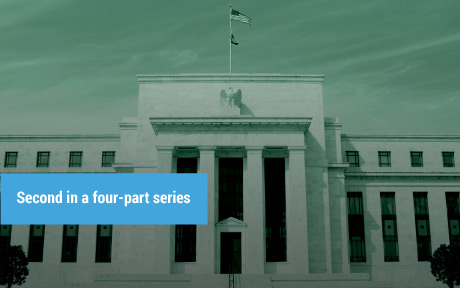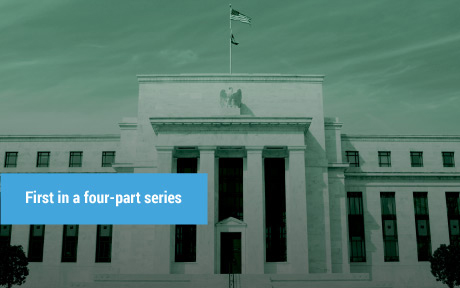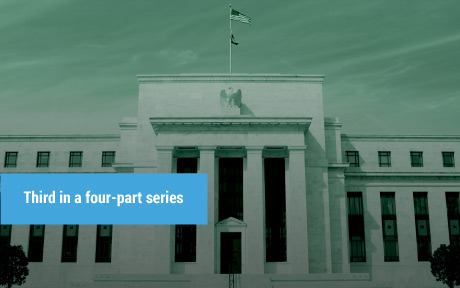Just Released: The New York Fed Staff Forecast—April 2016
Today, the Federal Reserve Bank of New York (FRBNY) is hosting the spring meeting of its Economic Advisory Panel (EAP). As has become the custom at this meeting, the FRBNY staff is presenting its forecast for U.S. growth, inflation, and the unemployment rate. Following the presentation, members of the EAP, which consists of leading economists in academia and the private sector, are asked to critique the staff forecast. Such feedback helps the staff evaluate the assumptions and reasoning underlying its forecast as well as the forecast’s key risks. The feedback is also an important part of the forecasting process because it informs the staff’s discussions with New York Fed President William Dudley about economic conditions. In that same spirit, we are sharing a short summary of the staff forecast in this post; for more detail, see the FRBNY Staff Outlook Presentation from the EAP meeting on our website.
Just Released: Introducing the New York Fed Staff Nowcast

What is the weather today? You don’t need to be a meteorologist to answer this question. Just take a look outside the window. Macroeconomists do not have this luxury. The first official estimate of GDP this quarter will not be published until the end of July. In fact, we don’t even know what GDP was last quarter yet! But while we wait for these crucial data, we float in a sea of information on all aspects of the economy: employment, production, sales, inventories, you name it. . . . Processing this information to figure out if it is rainy or sunny out there in the economy is the bread and butter of economists on trading desks, at central banks, and in the media. Thankfully, recent advances in computational and statistical methods have led to the development of automated real-time solutions to this challenging big data problem, with an approach commonly referred to as nowcasting. This post describes how we apply these techniques here at the New York Fed to produce the FRBNY Nowcast, and what we can learn from it. It also serves as an introduction to our Nowcasting Report, which we will update weekly on our website starting this Friday, April 15.
Reconciling Survey‑ and Market‑Based Expectations for the Policy Rate

In our previous post [LINK], we showed that the gap between the market-implied path for the federal funds rate and the survey-implied mean expectations for the federal funds rate from the Survey of Primary Dealers (SPD) and the Survey of Market Participants (SMP) narrowed from the December survey to the January survey.
How Do Survey‑ and Market‑Based Expectations of the Policy Rate Differ?

Over the past year, market pricing on interest rate derivatives linked to the federal funds rate have suggested a significantly lower expected path of the policy rate than responses to the New York Fed’s Survey of Primary Dealers (SPD) and Survey of Market Participants (SMP). However, this gap narrowed considerably from December 2015 to January 2016, before widening slightly at longer horizons in March. This post argues that the narrowing between December and January was mostly the result of survey respondents placing greater weight on lower rate outcomes, while the subsequent widening in February and March likely reflects an increased demand for insurance against states of the world where the policy rate remains at very low levels.
How the Fed Smoothed Quarter‑End Volatility in the Fed Funds Market
The federal funds market is an important source of short-term funding for U.S. banks.
From the Vault: The Path of Interest Rates
How Do Central Bank Balance Sheets Change in Times of Crisis?
Counterparties and Collateral Requirements for Implementing Monetary Policy

What types of counterparties can borrow from or lend to a central bank, and what kind of collateral must they possess in order to receive a loan? These are two key aspects of a central bank’s monetary policy implementation framework. Since at least the nineteenth century, it has been understood that an important role of central banks is to lend to solvent but illiquid institutions, particularly during a crisis, as this provides liquidity insurance to the financial system. They also provide liquidity to markets during normal times as a means to implement monetary policy. Central banks that rely on scarcity of reserves need to adjust the supply of liquidity in the market, as described in our previous post[add link]. In this post, we focus on liquidity provision related to the conduct of monetary policy .
Standard Elements of a Monetary Policy Implementation Framework

Emily Eisner, Antoine Martin, and Ylva Søvik In the minutes of the July 2015 Federal Open Market Committee (FOMC) meeting, the chair indicated that Federal Reserve staff would undertake an extended effort to evaluate potential long-run monetary policy implementation frameworks. But what is a central bank’s monetary policy implementation framework? In a series of four […]













 RSS Feed
RSS Feed Follow Liberty Street Economics
Follow Liberty Street Economics